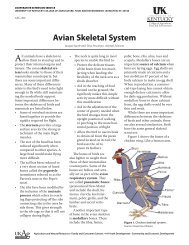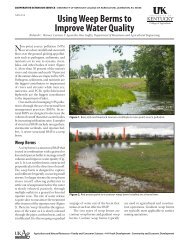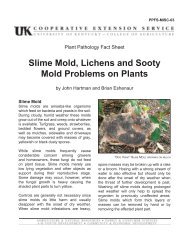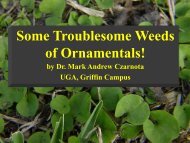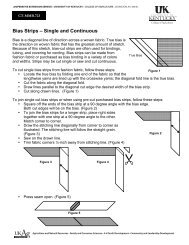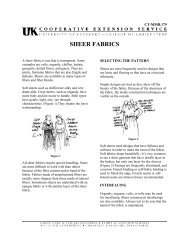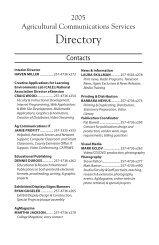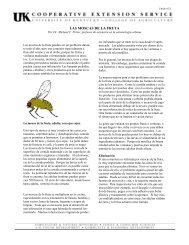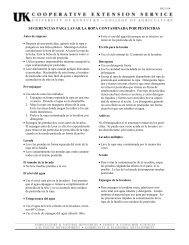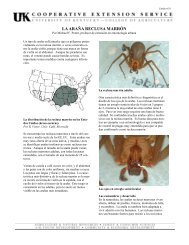ID-182: Wobbler Syndrome in Horses - UK College of Agriculture ...
ID-182: Wobbler Syndrome in Horses - UK College of Agriculture ...
ID-182: Wobbler Syndrome in Horses - UK College of Agriculture ...
Create successful ePaper yourself
Turn your PDF publications into a flip-book with our unique Google optimized e-Paper software.
COOPERATIVE EXTENSION SERVICE • UNIVERSITY OF KENTUCKY COLLEGE OF AGRICULTURE, LEXINGTON, KY, 40546<br />
<strong>ID</strong>-<strong>182</strong><br />
<strong>Wobbler</strong> <strong>Syndrome</strong> <strong>in</strong> <strong>Horses</strong><br />
Fernanda C. Camargo, Animal and Food Sciences, and Jennifer Janes, Veter<strong>in</strong>ary Science<br />
Introduction<br />
<strong>Wobbler</strong> syndrome, or cervical vertebral<br />
malformation (CVM), is a devastat<strong>in</strong>g<br />
disease that can affect a horse’s<br />
neurologic and musculoskeletal systems.<br />
It is a structural narrow<strong>in</strong>g <strong>of</strong> the sp<strong>in</strong>al<br />
canal due to a variety <strong>of</strong> vertebral<br />
malformations and leads to sp<strong>in</strong>al cord<br />
compression. As a result, horses exhibit<br />
cl<strong>in</strong>ical signs <strong>of</strong> spasticity, ataxia, and lack<br />
<strong>of</strong> coord<strong>in</strong>ation.<br />
Cervical vertebral <strong>in</strong>stability and<br />
cervical static stenosis are the two dist<strong>in</strong>ct<br />
types <strong>of</strong> CVM. Cervical vertebral<br />
<strong>in</strong>stability causes dynamic sp<strong>in</strong>al cord<br />
compression—occurr<strong>in</strong>g when the neck<br />
is flexed. <strong>Horses</strong> with dynamic lesions are<br />
typically 4 to 18 months <strong>of</strong> age, and the<br />
location <strong>of</strong> the compression is typically<br />
C3-5 (between the cervical vertebrae 3<br />
and 5).<br />
Cervical static stenosis typically affects<br />
horses between 1 and 4 years <strong>of</strong> age and<br />
is characterized by narrow<strong>in</strong>g <strong>of</strong> the<br />
cervical canal C5-7 (between the cervical<br />
vertebrae 5 and 7). The compression that<br />
results is static—occurr<strong>in</strong>g regardless <strong>of</strong><br />
neck position.<br />
These dist<strong>in</strong>ctions <strong>of</strong> dynamic versus<br />
static compression are made on the basis<br />
<strong>of</strong> a myelogram, a diagnostic technique<br />
that is discussed later <strong>in</strong> this publication.<br />
It is important to note the dist<strong>in</strong>ction<br />
between these two classifications is not<br />
always clear. <strong>Horses</strong> have been reported<br />
to have a narrowed canal (associated with<br />
cervical static stenosis) extend<strong>in</strong>g from<br />
C3 to C7 (<strong>in</strong>clud<strong>in</strong>g vertebrae generally<br />
associated with both cervical vertebral<br />
<strong>in</strong>stability and cervical static stenosis).<br />
This disease has been reported <strong>in</strong> a<br />
number <strong>of</strong> breeds, with Thoroughbreds,<br />
Quarter <strong>Horses</strong>, and Warmbloods be<strong>in</strong>g<br />
those most commonly affected. The M<strong>in</strong>iature<br />
Horse is the only breed that has<br />
escaped diagnosis <strong>of</strong> wobbler syndrome.<br />
Typically, wobbler syndrome is<br />
thought <strong>of</strong> as a developmental disease<br />
<strong>of</strong> young horses and is even <strong>in</strong>cluded<br />
<strong>in</strong> the classification <strong>of</strong> developmental<br />
orthopedic diseases by some authors.<br />
Researchers have looked at this disease<br />
<strong>in</strong> horses over the age <strong>of</strong> 4 and concluded<br />
that it should be kept as a differential<br />
diagnosis <strong>in</strong> older horses as well.<br />
Causes<br />
The exact cause <strong>of</strong> wobbler syndrome<br />
<strong>in</strong> horses is unknown. It is believed that<br />
the syndrome is caused by genetic predisposition,<br />
feed<strong>in</strong>g excessive amounts <strong>of</strong><br />
energy and other nutrients, rapid growth,<br />
physical trauma, decreased copper/<br />
<strong>in</strong>creased z<strong>in</strong>c levels, or a comb<strong>in</strong>ation<br />
<strong>of</strong> these factors.<br />
A gender predisposition exists, with<br />
some reports <strong>of</strong> males be<strong>in</strong>g affected up<br />
to six times more frequently than females.<br />
The gender difference may result from<br />
the <strong>in</strong>fluence <strong>of</strong> estrogen and testosterone<br />
on growth rates. Classically, the<br />
affected horse is a male with long neck<br />
length and <strong>in</strong>creased size as compared<br />
to age-matched controls.<br />
Much <strong>in</strong>vestigation has been done on<br />
the genetic component <strong>of</strong> this disease,<br />
<strong>in</strong>clud<strong>in</strong>g pedigree analysis and breed<strong>in</strong>g<br />
studies. A breed<strong>in</strong>g trial <strong>of</strong> confirmed<br />
stallions and mares did not yield affected<br />
progeny. Although the <strong>of</strong>fspr<strong>in</strong>g were not<br />
confirmed wobblers, they did however<br />
exhibit other developmental orthopedic<br />
diseases, <strong>in</strong>clud<strong>in</strong>g osteochondrosis, physitis,<br />
and contracted tendons. This study<br />
effectively ruled out a simple recessive<br />
or simple dom<strong>in</strong>ant mode <strong>of</strong> <strong>in</strong>heritance<br />
but did not rule out a more complex<br />
mode <strong>of</strong> <strong>in</strong>heritance. The genetic component<br />
rema<strong>in</strong>s <strong>of</strong> <strong>in</strong>terest for cont<strong>in</strong>ued<br />
research.<br />
The two causes <strong>of</strong> the syndrome that<br />
are the easiest to control are nutritional<br />
imbalance and physical trauma.<br />
Nutritional imbalance can be avoided<br />
by feed<strong>in</strong>g a balanced ration that meets<br />
the nutrient requirements for the particular<br />
class <strong>of</strong> horse be<strong>in</strong>g fed. For more<br />
<strong>in</strong>formation on feed<strong>in</strong>g, consult the<br />
Kentucky Cooperative Extension series<br />
on equ<strong>in</strong>e nutrition, ASC 111-115.<br />
Physical trauma usually results from<br />
<strong>in</strong>jury, particularly when a young horse is<br />
tied up for the first time or when a horse<br />
is cast <strong>in</strong> a stall.<br />
Cl<strong>in</strong>ical Signs<br />
Malformation most commonly occurs<br />
between the 3-4, 4-5, or 5-6 cervical vertebrae,<br />
depend<strong>in</strong>g on the type <strong>of</strong> CVM.<br />
Lesions occur most frequently at C3-4 or<br />
C4-5 for cervical vertebral <strong>in</strong>stability and<br />
compression at C5-6 or C6-7 for cervical<br />
static stenosis. However, malformation,<br />
lesions, and compression have been reported<br />
on other cervical vertebrae.<br />
These malformed or compressed<br />
vertebrae press aga<strong>in</strong>st the sp<strong>in</strong>al cord<br />
and <strong>in</strong>terfere with messages be<strong>in</strong>g sent<br />
by the bra<strong>in</strong>. Interference with normal<br />
nerve transmission from the bra<strong>in</strong> to the<br />
legs then leads to noticeable lack <strong>of</strong> coord<strong>in</strong>ation<br />
(ataxia). Ataxia is usually seen<br />
<strong>in</strong> the h<strong>in</strong>dquarters. As the condition<br />
persists, weight loss and weakness may<br />
be noticeable. Cl<strong>in</strong>ical signs may appear<br />
suddenly or gradually, follow<strong>in</strong>g known<br />
or suspected trauma, and may <strong>in</strong>crease <strong>in</strong><br />
severity until death, although death from<br />
wobbler syndrome is unusual. The horse<br />
may show periods <strong>of</strong> slight improvement<br />
but will never completely recover if aggressive<br />
treatment is not adm<strong>in</strong>istered.<br />
“<strong>Wobbler</strong>’s heel” is another cl<strong>in</strong>ical sign<br />
that occurs when the horse is <strong>in</strong> advanced<br />
stages <strong>of</strong> the syndrome and lack <strong>of</strong> coord<strong>in</strong>ation<br />
is evident. It is characterized by<br />
the horse reach<strong>in</strong>g forward with the back<br />
foot and lacerat<strong>in</strong>g the bulbs <strong>of</strong> the heel <strong>of</strong><br />
the front foot. This action can cause lameness,<br />
further complicat<strong>in</strong>g the syndrome.<br />
Diagnosis<br />
It is important to understand that<br />
multiple disease processes can lead to<br />
ataxia <strong>in</strong> a horse, <strong>in</strong>clud<strong>in</strong>g, <strong>in</strong> addition<br />
to wobbler syndrome, equ<strong>in</strong>e protozoal<br />
myeloencephalitis (EPM), West Nile virus<br />
(WNV), eastern and western equ<strong>in</strong>e<br />
encephalitis, equ<strong>in</strong>e herpes virus (EHV),<br />
rabies, trauma, equ<strong>in</strong>e motor neuron<br />
<strong>Agriculture</strong> and Natural Resources • Family and Consumer Sciences • 4-H Youth Development • Community and Economic Development<br />
EXTENSION
disease, and equ<strong>in</strong>e degenerative myeloencephalopathy<br />
(EDM). A thorough<br />
neurologic exam<strong>in</strong>ation and diagnostic<br />
evaluation by a veter<strong>in</strong>arian <strong>in</strong> conjunction<br />
with owner observation and knowledge<br />
<strong>of</strong> the horse’s vacc<strong>in</strong>ation status<br />
are therefore crucial for the appropriate<br />
diagnosis.<br />
Diagnosis <strong>of</strong> sp<strong>in</strong>al cord damage requires<br />
quality radiographs <strong>of</strong> the cervical<br />
region. A radiograph measures the diameter<br />
<strong>of</strong> the cervical sp<strong>in</strong>al canal <strong>in</strong> order<br />
to compare it aga<strong>in</strong>st established ratios<br />
so that narrowed sites can be identified.<br />
A myelogram is also used. It determ<strong>in</strong>es<br />
whether the compression is dynamic<br />
or static. This procedure is done<br />
under general anesthesia and <strong>in</strong>volves <strong>in</strong>ject<strong>in</strong>g<br />
radio-opaque dye <strong>in</strong>to the region<br />
beh<strong>in</strong>d the head <strong>in</strong> the area surround<strong>in</strong>g<br />
the sp<strong>in</strong>al cord. Radiographs are taken<br />
promptly after <strong>in</strong>jection.<br />
High-quality radiographs and a myelogram<br />
can be expensive and require<br />
special equipment and expertise. Horse<br />
owners and veter<strong>in</strong>arians can perform<br />
less costly tests to determ<strong>in</strong>e whether a<br />
horse has CVM.<br />
The first sign that should prompt the<br />
owner to adm<strong>in</strong>ister these tests is lack<br />
<strong>of</strong> coord<strong>in</strong>ation <strong>of</strong> the rear legs. <strong>Horses</strong><br />
can compensate with their vision to coord<strong>in</strong>ate<br />
the forelimbs, but they cannot<br />
visually compensate for their h<strong>in</strong>d legs,<br />
so they will stumble.<br />
Turn<strong>in</strong>g the horse <strong>in</strong> a small circle is<br />
a quick and easy test to detect wobbler<br />
syndrome. A horse suffer<strong>in</strong>g from the<br />
syndrome will sw<strong>in</strong>g the rear legs out<br />
while mak<strong>in</strong>g the turn. The horse also<br />
will have trouble back<strong>in</strong>g up. Instead <strong>of</strong><br />
back<strong>in</strong>g up their rear legs <strong>in</strong> a diagonal,<br />
two-beat fashion with their front legs, as<br />
is normal, the horse will back up with the<br />
front legs until it becomes awkward and<br />
then will hop backwards with the rear<br />
legs.<br />
Another way <strong>of</strong> detect<strong>in</strong>g wobbler<br />
syndrome is the sway test. Two people are<br />
necessary to adm<strong>in</strong>ister it. One person<br />
walks the horse away while the other<br />
person grabs the tail and pulls the horse<br />
to one side. A normal horse will allow<br />
that to happen once before rapidly correct<strong>in</strong>g<br />
itself. However, a horse exhibit<strong>in</strong>g<br />
wobbler syndrome cannot tell where its<br />
limbs are, especially the h<strong>in</strong>d limbs, thus<br />
you can easily pull the horse over to one<br />
side.<br />
A third simple test used rout<strong>in</strong>ely is<br />
to pick up the horse’s tail. If absolutely<br />
no resistance occurs, the horse is hav<strong>in</strong>g<br />
some type <strong>of</strong> problem with normal nerve<br />
function <strong>in</strong> its sp<strong>in</strong>al cord. The weakness<br />
<strong>in</strong> tail resistance may be due to the pressure<br />
on the sp<strong>in</strong>al cord caused by the<br />
malformation <strong>of</strong> the cervical vertebrae.<br />
Contact your veter<strong>in</strong>arian if you suspect<br />
your horse has developed wobbler syndrome<br />
or any other neurological disease.<br />
Treatments<br />
<strong>Horses</strong> with this syndrome can be<br />
treated with drug therapy, surgery, or<br />
aggressive management.<br />
Certa<strong>in</strong> drugs decrease the nerve tissue<br />
swell<strong>in</strong>g and <strong>in</strong>tracranial pressure.<br />
Some examples <strong>of</strong> these drugs <strong>in</strong>clude<br />
osmotic agents (for example, mannitol),<br />
dimethylsulfoxide (DMSO), and diuretics<br />
(for example, furosemide). Steroids<br />
are frequently used cl<strong>in</strong>ically for sp<strong>in</strong>al<br />
cord and head trauma, but experiments<br />
have shown no benefit for wobbler’s syndrome<br />
because steroid therapy is targeted<br />
at treat<strong>in</strong>g the acute <strong>in</strong>flammation <strong>in</strong> the<br />
sp<strong>in</strong>al cord that results from the compression<br />
but does not correct the underly<strong>in</strong>g<br />
problem.<br />
Surgery <strong>in</strong>volves placement <strong>of</strong> a titanium<br />
basket with<strong>in</strong> the vertebral bodies<br />
at the compression site, which serves to<br />
promote fusion <strong>of</strong> the vertebrae to relieve<br />
the compression. The fusion <strong>of</strong> the bones<br />
aids <strong>in</strong> remov<strong>in</strong>g the <strong>in</strong>stability caused by<br />
the malformation or malrticulations <strong>of</strong><br />
the adjacent vertebrae. Surgery is an option<br />
<strong>in</strong> appropriate cases; it’s important<br />
to consider the number and location <strong>of</strong><br />
compressions, degree <strong>of</strong> ataxia, duration<br />
<strong>of</strong> cl<strong>in</strong>ical signs, and the horse’s <strong>in</strong>tended<br />
use. Surgery also requires a significant<br />
post-operative recovery time to allow<br />
for adequate heal<strong>in</strong>g. In the long term,<br />
complete recovery and return to normal<br />
athletic pursuits have occurred <strong>in</strong> 50-55%<br />
<strong>of</strong> cases Involv<strong>in</strong>g surgical treatment.<br />
Because <strong>of</strong> the later age <strong>of</strong> onset (2 to 4<br />
years) <strong>of</strong> this disease, some animals may<br />
not necessarily return to rac<strong>in</strong>g but may be<br />
able to compete adequately <strong>in</strong> other fields.<br />
Drug therapy and surgery are very<br />
costly and are not always practical for<br />
most horse owners. Aggressive nutritional<br />
management and controlled<br />
exercise coupled with early diagnosis<br />
have recently proven to be successful.<br />
The treatment is targeted at normaliz<strong>in</strong>g<br />
growth rates and allow<strong>in</strong>g for proper<br />
bone remodel<strong>in</strong>g with<strong>in</strong> the cervical<br />
canal. Exercise is restricted <strong>in</strong> order to<br />
reduce the likelihood <strong>of</strong> trauma. Nutrition<br />
is focused on attention to appropriate<br />
calcium and phosphorus ratios and<br />
copper and z<strong>in</strong>c supplementation. A<br />
quality grass hay can serve as a source <strong>of</strong><br />
roughage. This therapy takes time and<br />
patience before results are seen. Work<br />
closely with your veter<strong>in</strong>arian or equ<strong>in</strong>e<br />
extension specialist to establish your<br />
horse’s proper nutritional requirements.<br />
Conclusion<br />
<strong>Wobbler</strong> syndrome significantly impacts<br />
the athletic potential <strong>of</strong> affected<br />
horses and <strong>in</strong>fluences the equ<strong>in</strong>e <strong>in</strong>dustry<br />
<strong>in</strong> a multitude <strong>of</strong> ways, both f<strong>in</strong>ancial and<br />
emotional. Owners are <strong>of</strong>ten left with a<br />
difficult decision regard<strong>in</strong>g treatment<br />
once a diagnosis is made. Euthanasia<br />
should be strongly considered, as wobbler<br />
syndrome can be unsafe for horse<br />
and rider.<br />
Current molecular and genetic techniques<br />
are be<strong>in</strong>g used by researchers <strong>in</strong><br />
efforts to answer the significant question<br />
<strong>of</strong> the exact role <strong>of</strong> genetics <strong>in</strong> the<br />
disease’s development. Research also<br />
is under way on use <strong>of</strong> current imag<strong>in</strong>g<br />
techniques to re-evaluate vertebral<br />
structure as well as bone metabolism.<br />
All this research is focused on further<br />
elucidat<strong>in</strong>g the pathogenesis <strong>of</strong> wobbler<br />
syndrome <strong>in</strong> order to improve management<br />
and therapeutic practices <strong>of</strong> this<br />
disease.<br />
Educational programs <strong>of</strong> Kentucky Cooperative Extension serve all people regardless <strong>of</strong> race, color, age, sex, religion, disability, or national orig<strong>in</strong>. Issued <strong>in</strong> furtherance <strong>of</strong> Cooperative<br />
Extension work, Acts <strong>of</strong> May 8 and June 30, 1914, <strong>in</strong> cooperation with the U.S. Department <strong>of</strong> <strong>Agriculture</strong>, M. Scott Smith, Director, Land Grant Programs, University <strong>of</strong> Kentucky<br />
<strong>College</strong> <strong>of</strong> <strong>Agriculture</strong>, Lex<strong>in</strong>gton, and Kentucky State University, Frankfort. Copyright © 2010 for materials developed by University <strong>of</strong> Kentucky Cooperative Extension. This<br />
publication may be reproduced <strong>in</strong> portions or its entirety for educational or nonpr<strong>of</strong>it purposes only. Permitted users shall give credit to the author(s) and <strong>in</strong>clude this copyright<br />
notice. Publications are also available on the World Wide Web at www.ca.uky.edu.<br />
Issued 8-2010



